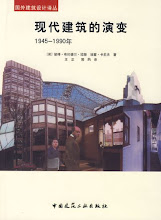Tuesday 30 July 2013
Saturday 27 July 2013
SPANISH EDITION
I am very pleased to announce the publication of the new Spanish language edition of my and Peter Blundell Jones's 2007 book MODERN ARCHITECTURE THROUGH CASE STUDIES 1945-1990 as MODELOS DE LA ARQUITECTURA MODERNA Volumen II 1945-1990 published by Editorial Reverté.
Edited by Jorge Sainz, and translated by Roberto Osuna, Ramon Serrano and Maria Teresa Valcarce the book is available here
Descripción
Este libro es la segunda parte de un riguroso trabajo de investigación que intenta observar con un nuevo enfoque el Movimiento Moderno y enmarcarlo según unos criterios más amplios. A diferencia de las historias canónicas de la arquitectura moderna, este estudio exalta la profundidad y complejidad de ese movimiento, y resalta no tanto sus propósitos comunes como su espíritu explorador y la consiguiente diversidad creativa.
En este estudio se intenta también hacer una aproximación más cercana a los edificios, pues muchas historias del pasado han mencionado los edificios sólo de pasada. Esto hace que el enfoque de este libro sea diferente y que tenga además un marcado carácter didáctico, pues el libro va dirigido fundamentalmente a los estudiantes de arquitectura.
Para ello se ha adoptado el método del “estudio de modelos” o casos concretos (case Studies), de manera que cada uno de los capítulos que componen el libro está dedicado monográficamente a un ejemplos singular, en este caso del periodo que va desde el final de la II Guerra Mundial hasta la caída del Muro de Berlín.
Así pues, los capítulos abarcan desde la continuación del Movimiento Moderno en la posguerra (con obras de Ludwig Mies van der Rohe, Hans Scharoun, los Eames o Egon Eiermann) hasta la corriente denominada “deconstructivista” (representada aquí por Peter Eisenman), pasando por la renovación propiciada por el Team Ten (Aldo van Eyck, los Smithson y Giancarlo De Carlo), algunas figuras singulares (como Gottfried Böhm, Sigurd Lewerentz, Günther Behnisch o Carlo Scarpa), las obras participativas (como las de Lucien Kroll y Ralph Erskine), los dos últimos “maestros” (Louis Kahn y James Stirling), los ideólogos posmodernos (Aldo Rossi y Robert Venturi) y la exaltación de la tecnología punta o hig tech (Norman Foster y Piano & Rogers).
Índice
Prólogo. Láminas. Introducción. Charles y Ray Eames. Casa Eames, Pacific Palisades, 1945-1949. Hans Scharoun. Teatro Nacional, Mannheim, 1953. Egon Eiermann y Sep Ruf. Pabellón de Alemania, Expo de Bruselas, 1958. Aldo van Eyck. Orfanato, Amsterdam, 1954-1959. Gottfried Böhm. Ayuntamiento de Bensberg, 1962-1971. Sigurd Lewerentz. Iglesia de San Pedro, Klippan, 1963-1966. Alison y Peter Smithson. Edificio 'The Economist', Londres, 1964. James Stirling y James Gowan. Escuela de Ingeniería, Leicester, 1959-1964. Ludwig Mies van der Rohe. Neue Nationalgalerie, Berlín, 1968. Günter Behnisch. Instalaciones olímpicas, Múnich, 1967-1972. Carlo Scarpa. Museo de Casteldecchio, Verona, 1957-1974. Louis Kahn. Museo Kimbell, Fort Worth, 1966-1972. Lucien Kroll. Casa de la Medicina, Bruselas, 1969-1972. Ralph Erskine. Viviendas en Byker, Newcastle, 1969-1975. Giancarlo de Carlo. Escuela de Magisterio, Urbino, 1968-1976. Norman Foster. Willis Faber & Dumas, Ipswich, 1971-1975. Renzo Piano y Richard Rogers. Centro Pompidou, París, 1969-1977. Aldo Rossi. Cementerio de S. Cataldo, Módena, 1971-1978. Peter Eisenman. Centro Wexner, Columbus (Ohio), 1983-1989. Robert Venturi y Denise Scott Brown. Ala Sainsbury, Londres, 1986-1991. Conclusión. Bibliografía.
Wednesday 24 July 2013
Sunday 21 July 2013
Thursday 18 July 2013
CHINESE EDITION
I am very pleased to announce the publication of the Chinese edition of my 2006 book URBAN ETHIC: DESIGN IN THE CONTEMPORARY CITY 城市伦理--当代城市设计 Published by China Architecture & Building Press the book is available here
Monday 15 July 2013
Friday 12 July 2013
Tuesday 9 July 2013
The Architectural Consequences of State Secularism
Next month will see the publication of the latest volume of the Ashgate Studies in Architecture series edited by Eamonn Canniffe
Beyond Anitkabir: The Funerary Architecture of Atatürk by Christopher S. Wilson
There have been five different settings that at one time or another have contained the dead body of Mustafa Kemal Ataturk, organiser of the Turkish War of Independence (1919-1923) and first president of the Republic of Turkey. Narrating the story of these different architectural constructions - the bedroom in Dolmabahce Palace, Istanbul, where he died; a temporary catafalque in this same palace; his funeral stage in Turkey's new capital Ankara; a temporary tomb in the Ankara Ethnographic Museum and his permanent and monumental mausoleum in Ankara, known in Turkish as 'Anitkabir' (Memorial Tomb) - this book also describes and interprets the movement of Ataturk's body through the cities of Istanbul and Ankara and also the nation of Turkey to reach these destinations.It examines how each one of these locations - accidental, designed, temporary, permanent - has contributed in its own way to the construction of a Turkish national memory about Ataturk. Lastly, the two permanent constructions - the Dolmabahce Palace bedroom and Anytkabir - have changed in many ways since their first appearance in order to maintain this national memory. These changes are exposed to reveal a dynamic, rather than dull, impression of funerary architecture.
Saturday 6 July 2013
Subscribe to:
Posts (Atom)


































































